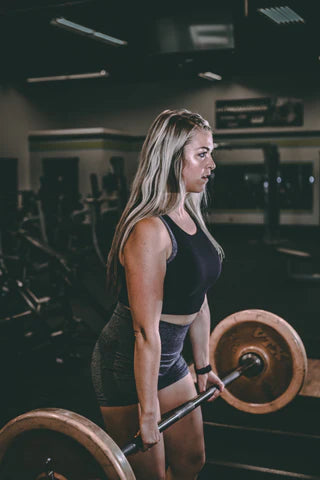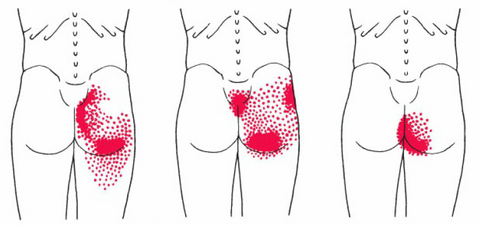The glutes are not always the easiest body part to target.
With an abundance of exercises out there like hip thrusts, lunges, and fire hydrants, why RDLs for glutes?
Glute RDLs utilize the power of the hip hinge to strengthen the glutes, lower back, and hamstrings.
Glute focused RDLs encourage you to step up your game and activate your glutes with an incredibly functional movement.
Take a chance on RDLs for glutes and let the results speak for themselves.
How To Do Glute Focused Romanian Deadlifts

Begin with the correct setup:
Stand both feet hip-width apart, holding a barbell or two dumbbells out in front of your thighs using an overhand grip.
Maintain a small bend in the knees (30%):
Unlike typical deadlifts, RDLs need some flexibility in the knees during the exercise. Slightly bent, but not locked.
Begin the action by moving your hips back and maintaining a neutral spine. Keep an upright posture throughout the activity.
Lower the weight:
Bring the weight down towards the front of your legs while holding it close to the center of your body. Lower the weight until you feel a stretch in your hamstrings and avoid rounding your back.
As you lower the weight, focus on your glutes to propel your hips forward and back to the starting position. With enough weight and proper form you should feel a strain on the upper buttocks.
Control the movement:
Don't use momentum or a jerking-type motion to lift the weight. Work on a slower and more controlled motion to properly activate the glutes and prevent lower back pain from rdls.
How To Do RDLs For Glutes With Dumbells
The only difference when completing glute focused RDLs with dumbells, as opposed to barbells, is the location of the weight. Having one weight in each hand allows you to hold the dumbells more at your sides (angled) instead of in a straight line.
Take the same steps: Follow all of the steps above to achieve the ideal RDL form while carrying the dumbbells at your sides.

What Muscles Do Glute RDLs Work?



Inner thighs - adductor magnus
Lower back - erector spinae
RDL Form For Glutes
A few tips to remember when completing RDLs for glutes:
Hip hinge: To properly attack the glutes, hinge at your hips instead of bending at the waist.
Neutral spine: Maintain a straight back and proper pelvic tilt during glute rdls to avoid the risk of injury as you activate your glutes.

Slight knee bend: While your knees should be bent slightly, prevent too much bend to avoid putting excessive pressure on your joints.
Tight core: Throughout the movement keep your core braced for stability and a steady all-around motion.
Weight path: As you lower and raise the weight, keep it close to your body. This will save your lower back while placing further emphasis on your glutes and hamstrings.
Glute Pain Relief
The key to fixing pain-filled glutes is breaking up the tight tissue.
Glute trigger points are common and can cause a world of pain.
Pinpoint the affected area by locating where the muscle is the tightest.
For muscles such as the Gluteus Medius or Minimus, I will only ever use the QL Claw.
Trigger point release followed by glute stretches is a surefire way to relieve built-up tension.
RDLs For Glutes - Mistakes To Avoid
Rounding the Back:
One of the most prevalent mistakes is allowing the back to round throughout the motion. This not only lowers the glute RDL's efficacy, but also places unnecessary stress on the back.
Maintain a neutral spine by using your core muscles and raising your chest throughout the workout.
Overextending the Neck:
When focused on hip and lower body movements, it is easy to overlook the neck. Keep your head neutral, looking either slightly ahead or a bit downward. Avoid flexing your neck up or letting it fall too far forward.
Using Too Much Weight:
It might be tempting to load up the barbell, but doing so can affect your technique and increase your risk of injury. Espeically if you're new to the glute rdl, choose a weight which allows you to do the exercise with good form. Focus on progressively increasing the weight as you gain strength and perfect your form.
Neglecting Eccentric Control:
Failure to manage the descent of the lift can lead to lost gains and greater risk of injury. Slow down the action as you drop the weight, focusing on keeping tension in the glutes and hamstrings throughout the lift.
Overworking Sore Glutes:
A common mistake is overworking the glute muscles and not giving them enough rest time. Deep buttock pain and glute soreness are two different things and knowing the difference is crucial.
RDLs For Glutes - FAQ:
What is the difference between a glute RDL and a traditional romanian dead lift?
The main difference between the glute rdl and traditional rdl is a slight more bend in the knees with the glute rdl. A roughly 30% bend in the knee is standard, and you want to drive your glutes back and hinge at your hips, instead of pulling vertically with an emphasis on the lower back and hamstrings.
Why do I feel RDLs in my back?
RDLs in your back could point to poor lifting posture or weakened muscles that support your spine such as the quadratus lumborum. To reduce back pain, keep your spine neutral, core tight, and glutes engaged throughout the exercise.
Why don’t I feel RDLs in my glutes?
If you don't feel RDLs in your glutes, it might be because of incorrect form or insufficient glute activation. Make sure you're extending your hips back, staying engaged at the top, and keeping the weight close to your legs to get the most glute activation.
If your glutes are sore are they growing?
The chances are yes! if you're keeping up with your diet and staying generally healthy sore glutes are an indication that the muscle is growing.
What is the best exercise for glute growth?
There are several great glute-building exercises such as hip thrusts, glute bridges, lunges, squats, sumo squats for glutes, and reverse hyperextensions.
What you choose depends on your fitness goals. Do you want to target the gluteus medius (outer glute), try the fire hydrant exercise. Do you want to increase explosiveness, go with the hip thrust.
Glute RDLs stick out because of their ability to strengthen and grow the most important buttock muscles while teaching ideal lifting techniques from the hips.
Incorporating a variety of workouts into your fitness routine can help to improve different aspects of growing and advancing your glute health.
Now that you've read about glute focused RDLs, check out our pages on gluteus maximus stretches, how to get a shelf on the upper glutes, or how to do the ATG split squat!
Sources:
[1] Donnelly, Joseph M. Travell, Simons & Simons Myofascial Pain and Dysfunction: the Trigger Point Manual. 3rd ed., Wolters Kluwer Health, 2019.
[2] Davies, Clair, and Amber Davies. The Trigger Point Therapy Workbook: Your Self-Treatment Guide for Pain Relief. 3rd ed., New Harbinger Publications, Inc., 2013.

